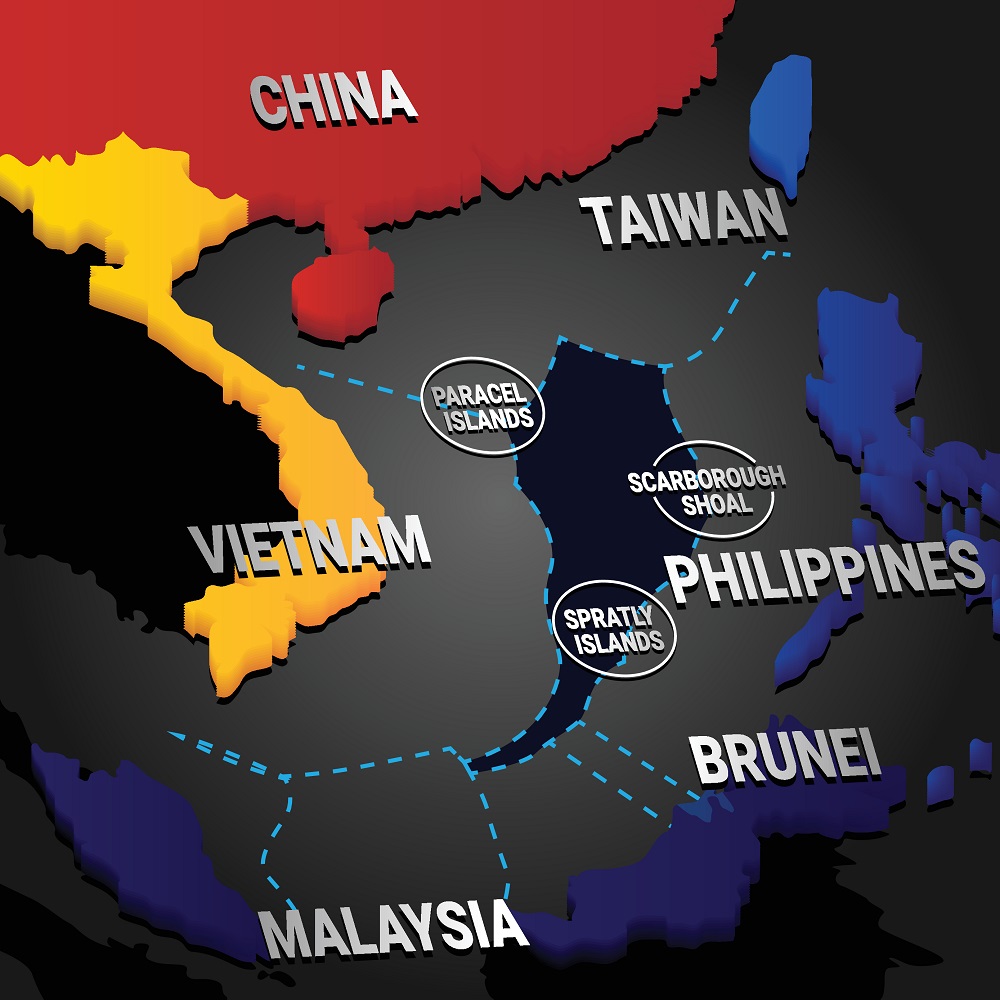
Geopolitical disputes: China and the Philippines in the South China Sea
by Eduardo García Torres
한국어로 읽기 Leer en español In Deutsch lesen Gap اقرأ بالعربية Lire en français Читать на русском The South China Sea (SCS) is a strategic region in international geopolitics and a hotspot of disputes involving sovereignty, economy, and security. This text analyzes the positions of two key actors in the region — China and the Philippines — whose growing tensions have been a defining factor in the evolution of the conflict. Located in Southeast Asia, the SCS borders China, Vietnam, the Philippines, Malaysia, Brunei, and Indonesia, and connects the Pacific to the Indian Ocean through the Strait of Malacca, one of the busiest maritime routes. Its wealth in fishery and energy resources has intensified disputes over the Pratas, Macclesfield, Paracel, and Spratly Archipelagos, which are claimed entirely or partially by China, the Philippines, Vietnam, and Malaysia. In this context, the SCS holds significant geopolitical importance. From the classical perspective of Alfred T. Mahan, maritime control is essential for a country to consolidate itself as a power, as it enables access to strategic resources, trade routes, and the projection of military power. Today, this remains a key factor of political, economic, and military influence in the macro-region that authors such as Ulises Granados (2022) refer to as the Indo-Asia-Pacific. On the other hand, from the perspective of critical geopolitics, the SCS conflict is a dispute rooted in the construction of geographic and political meanings. According to Gerard Toal, space is not fixed but rather a construction shaped by power relations and discourses. One example is its naming: China calls it the South Sea, the Philippines refer to it as the West Philippine Sea, and Vietnam calls it the East Sea. Each name not only reflects a territorial claim but also a geopolitical imaginary. Interests in the SCS date back to the late 19th and early 20th centuries, when Japan exerted control over some areas through the state and its corporations. However, after World War II, sovereignty over these territories remained undefined, leading to competing claims from neighboring countries. During the Cold War, the United States strengthened its alliance with the Philippines and other Southeast Asian nations to contain communism, while China consolidated its presence in areas like the Paracel Islands. This context has been key in shaping the current competition over the sea. The Chinese government claims sovereignty in the SCS based on historical precedents going back to the Han dynasty. Beijing argues it recovered the Spratly and Paracel Islands after World War II, invoking the Cairo Declaration (1943) and the Potsdam Declaration (1945), which called for the return of territories occupied by Japan. In 1958, China issued the Declaration on China’s Territorial Sea, incorporating the Pratas (Dongsha), Paracel (Xisha), Macclesfield (Zhongsha), and Spratly (Nansha) Islands into its sovereign territory. Later, in 2009, it reaffirmed its claim through the Nine-Dash Line (NDL), a delimitation drawn in 1947 that encompasses nearly 80% of the SCS. Although this line is not clearly defined in international law, Beijing maintains that it holds sovereign rights within it and that disputes should be resolved without intervention from extra-regional actors — a stance that contrasts with the Philippines’ actions, which have sought international support to strengthen their position. From China’s perspective, its claims in the SCS are essential to its sovereignty and national security. For this reason, it has increased its naval, paramilitary, and civilian presence. Maritime projection and control of trade routes are also key aspects of its strategy to advance initiatives such as the Belt and Road Initiative, which is fundamental to its regional and international economic growth. In contrast, the Philippines has claimed sovereignty over the Spratly Islands since the 1970s and has resorted to legal and media avenues to denounce China. In 1995, it protested China’s construction of structures on Mischief Reef, and in 1997, it stationed the Sierra Madre ship in the Spratlys. Today, the Philippine Navy maintains operations in the area. Moreover, in 2002, the Association of Southeast Asian Nations (ASEAN) and China signed the Declaration on the Conduct of Parties to promote the peaceful resolution of disputes. However, tensions escalated in 2009 when China reaffirmed the Nine-Dash Line. In response, in 2013, the Philippines brought the case before the Permanent Court of Arbitration (PCA), arguing that China was violating the 1982 United Nations Convention on the Law of the Sea and asserting its rights over exclusive economic zones. In 2016, the Permanent Court of Arbitration (PCA) ruled in favor of the Philippines, concluding that China's claims lacked legal basis under international law. However, China rejected the ruling, stating that it does not reflect its interpretation of territorial sovereignty based on its history and legal frameworks. Moreover, Beijing considered the Philippine complaint a unilateral action. In 2024, the Philippines enacted the “Maritime Zones Law” and the “Archipelagic Sea Lanes Act,” which define its maritime rights in the South China Sea. In response, China’s Ministry of Foreign Affairs rejected both laws, arguing they violate its sovereignty. From the Philippine perspective, China’s actions represent a challenge to its security, prompting it to seek support from ASEAN for a joint response in the SCS. However, the bloc’s positions are divided: the Philippines actively denounces China, Vietnam takes a more pragmatic approach, and Malaysia avoids confrontation. These differences have led ASEAN to adopt a moderate stance, prioritizing diplomacy over conflict. In summary, the Philippines is strengthening its alliance with the United States under the 1951 Mutual Defense Treaty, which ensures assistance in the event of an attack in the Pacific, including the SCS. This cooperation aligns with the U.S. geopolitical strategy in Asia, which has evolved from Obama’s “Asia Pivot” to the “Indo-Pacific” vision, focused on a “rules-based order” and the security of trade routes. However, the exclusion of China has led to perceptions that this strategy is a containment mechanism against the world’s second-largest economy. For example, China’s Foreign Minister Wang Yi argues that the U.S. strategy aims to “besiege and contain China” through alliances that promote confrontation. He also claims it undermines regional cooperation, while the Asian giant promotes a “community with a shared future in the Asia-Pacific” based on integration and stability. Thus, China employs the concept of the Asia-Pacific and, although it remains cautious in its rhetoric, insists that its approach prioritizes cooperation and avoids a bloc-based logic in the region. In this context, during Balikatan, a joint military exercise between the U.S. and the Philippines in April 2024, Washington deployed Typhon missile systems in the northern part of the country. By the end of the year, Manila expressed interest in acquiring them, which Beijing perceived as a threat. In 2025, Ferdinand Marcos Jr. stated he would reconsider the U.S. military presence if China ceased its territorial claims. China has not officially responded, and these remarks could be part of Philippine political rhetoric, reflecting its perception of threat in the region. Additionally, the Philippines has strengthened security cooperation with Japan, which also faces territorial disputes with China. In 2024, they signed a Reciprocal Access Agreement to facilitate military deployments, and Japan supported the modernization of the Philippine Navy. In 2025, both nations reaffirmed their commitment to a free and open Indo-Pacific. While Manila strengthens its position through strategic alliances, Beijing views this as an attempt to internationalize the conflict. Another point is that the Philippines’ approach varies depending on the administration in power. During Rodrigo Duterte’s presidency (2016–2022), Manila prioritized closer ties with Beijing, favoring economic cooperation. In contrast, the arrival of Ferdinand Marcos Jr. in 2022 strengthened the alliance with the United States, increasing defense and security cooperation, but also escalating tensions with China. On the other hand, while the U.S. has expanded its presence in the Asia-Pacific region, Trump’s first term (2017–2021) had a more isolationist approach compared to the Obama (2009–2017) and Biden (2021–2025) administrations. The Philippine government hopes to maintain the agreements reached in 2024, although their continuity will depend on how the new Trump administration (2025–) manages its Indo-Pacific strategy. Moreover, the Philippines cannot fully align with just one actor, as both China and the U.S. are essential to its economy. The United States is its main export market, according to the Philippine Statistics Authority, while China is its largest source of imported goods, top investor, infrastructure partner, and shares agreements such as the Regional Comprehensive Economic Partnership (RCEP). Therefore, while Manila strengthens its defense cooperation with the U.S. and maintains strategic interests in the South China Sea, its relationship with China remains crucial due to its economic importance. Final Considerations From a geopolitical perspective, cooperation between the Philippines and the United States seeks to counterbalance China's presence in the region, while China reinforces its position in the SCS for sovereignty and security reasons. In this context, the relationship between Manila and Washington, along with the stance of ASEAN members, will be decisive in the evolution of the conflict. Thus, the dispute in the South China Sea reflects a geopolitical competition between regional and extra-regional actors for control of strategic areas, where each defends its own interests. Although none of the parties appear to seek open conflict, increasing militarization and patrols have raised the risk of incidents that could escalate tensions. In this context, the future will depend on the willingness of actors to negotiate concessions, although the lack of consensus and divergent interests make a definitive solution unlikely in the short term. In this way, Alfred T. Mahan’s theories on maritime power remain relevant in the SCS, although their application is not absolute. Beyond the control of sea routes, the competition also unfolds through the construction of narratives by regional and external actors. The way these narratives shape alliances and perceptions will be key in defining power dynamics in the region.

















